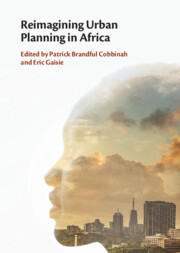Book contents
- Reimagining Urban Planning in Africa
- Reimagining Urban Planning in Africa
- Copyright page
- Contents
- Contributors
- Foreword
- Preface
- Acknowledgements
- Abbreviations
- Part I Understanding Sustainable Urban Planning in Africa
- Part II Case Studies on Urban Planning in African Countries
- Part III Sustainable Urban Planning in Africa
- 14 On the Need for Sustainable Digital Urban Infrastructure in Twenty-First-Century South African Cities
- 15 The South African Landownership Struggle
- 16 The 2030 Agenda, Climate Urbanism and Urban Planning in Zimbabwe
- 17 Urban Planning and Quality of Life of Urban Residents in Africa
- 18 Realising Rights in Complex Informal Settlements Contexts
- 19 Participatory Design Won’t Fix Unequal Southern African Cities
- 20 Enabling Smart Mobility in African Cities
- 21 On the Future of Urban Planning in Africa
- Index
- References
14 - On the Need for Sustainable Digital Urban Infrastructure in Twenty-First-Century South African Cities
from Part III - Sustainable Urban Planning in Africa
Published online by Cambridge University Press: 07 December 2023
- Reimagining Urban Planning in Africa
- Reimagining Urban Planning in Africa
- Copyright page
- Contents
- Contributors
- Foreword
- Preface
- Acknowledgements
- Abbreviations
- Part I Understanding Sustainable Urban Planning in Africa
- Part II Case Studies on Urban Planning in African Countries
- Part III Sustainable Urban Planning in Africa
- 14 On the Need for Sustainable Digital Urban Infrastructure in Twenty-First-Century South African Cities
- 15 The South African Landownership Struggle
- 16 The 2030 Agenda, Climate Urbanism and Urban Planning in Zimbabwe
- 17 Urban Planning and Quality of Life of Urban Residents in Africa
- 18 Realising Rights in Complex Informal Settlements Contexts
- 19 Participatory Design Won’t Fix Unequal Southern African Cities
- 20 Enabling Smart Mobility in African Cities
- 21 On the Future of Urban Planning in Africa
- Index
- References
Summary
In South African cities, achieving sustainable urban development requires reckoning with segregated and unequal geographies of apartheid. Apartheid-era planning logics were deliberately designed to sequester and exclude the majority of city residents and remain systemic impediments to sustainable urban living. While scholars typically consider sustainable physical infrastructures, this chapter considers the need for equitable digital infrastructures as complementary sustainable urban interventions across apartheid’s fault lines. Drawing on critical scholarly engagements with urban sustainability and infrastructure, and ethnographic approaches with employees and customers at a grass-roots ICT centre in Cape Town, it was found that while digital infrastructure appears highly formal and planned, residents often gain access to that infrastructure from grass-roots initiatives achieved through socio-technical and relational assemblages, themselves infrastructural in nature. Scholars and practitioners must attend to these assemblages: they offer potential for a reimagined African urban planning regime in which sustainable urban development exists alongside community self-sufficiency and enhanced democratic engagement.
Keywords
- Type
- Chapter
- Information
- Reimagining Urban Planning in Africa , pp. 239 - 260Publisher: Cambridge University PressPrint publication year: 2023



